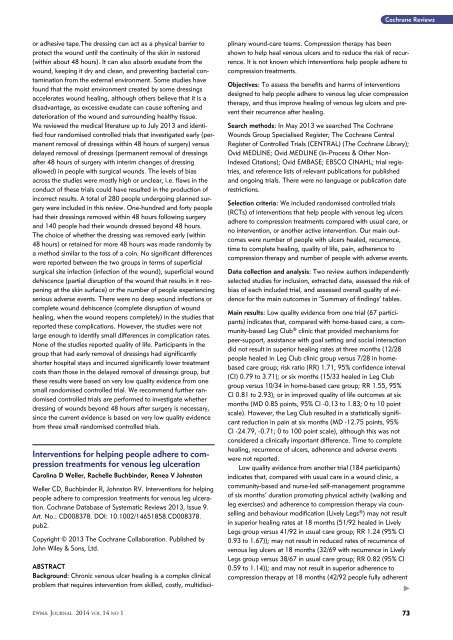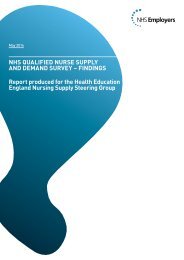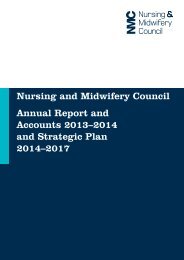Journal_1_2014_final_WEB
Journal_1_2014_final_WEB
Journal_1_2014_final_WEB
You also want an ePaper? Increase the reach of your titles
YUMPU automatically turns print PDFs into web optimized ePapers that Google loves.
Cochrane Reviews<br />
or adhesive tape.The dressing can act as a physical barrier to<br />
protect the wound until the continuity of the skin in restored<br />
(within about 48 hours). It can also absorb exudate from the<br />
wound, keeping it dry and clean, and preventing bacterial contamination<br />
from the external environment. Some studies have<br />
found that the moist environment created by some dressings<br />
accelerates wound healing, although others believe that it is a<br />
disadvantage, as excessive exudate can cause softening and<br />
deterioration of the wound and surrounding healthy tissue.<br />
We reviewed the medical literature up to July 2013 and identified<br />
four randomised controlled trials that investigated early (permanent<br />
removal of dressings within 48 hours of surgery) versus<br />
delayed removal of dressings (permanent removal of dressings<br />
after 48 hours of surgery with interim changes of dressing<br />
allowed) in people with surgical wounds. The levels of bias<br />
across the studies were mostly high or unclear, i.e. flaws in the<br />
conduct of these trials could have resulted in the production of<br />
incorrect results. A total of 280 people undergoing planned surgery<br />
were included in this review. One-hundred and forty people<br />
had their dressings removed within 48 hours following surgery<br />
and 140 people had their wounds dressed beyond 48 hours.<br />
The choice of whether the dressing was removed early (within<br />
48 hours) or retained for more 48 hours was made randomly by<br />
a method similar to the toss of a coin. No significant differences<br />
were reported between the two groups in terms of superficial<br />
surgical site infection (infection of the wound), superficial wound<br />
dehiscence (partial disruption of the wound that results in it reopening<br />
at the skin surface) or the number of people experiencing<br />
serious adverse events. There were no deep wound infections or<br />
complete wound dehiscence (complete disruption of wound<br />
healing, when the wound reopens completely) in the studies that<br />
reported these complications. However, the studies were not<br />
large enough to identify small differences in complication rates.<br />
None of the studies reported quality of life. Participants in the<br />
group that had early removal of dressings had significantly<br />
shorter hospital stays and incurred significantly lower treatment<br />
costs than those in the delayed removal of dressings group, but<br />
these results were based on very low quality evidence from one<br />
small randomised controlled trial. We recommend further randomised<br />
controlled trials are performed to investigate whether<br />
dressing of wounds beyond 48 hours after surgery is necessary,<br />
since the current evidence is based on very low quality evidence<br />
from three small randomised controlled trials.<br />
Interventions for helping people adhere to compression<br />
treatments for venous leg ulceration<br />
Carolina D Weller, Rachelle Buchbinder, Renea V Johnston<br />
Weller CD, Buchbinder R, Johnston RV. Interventions for helping<br />
people adhere to compression treatments for venous leg ulceration.<br />
Cochrane Database of Systematic Reviews 2013, Issue 9.<br />
Art. No.: CD008378. DOI: 10.1002/14651858.CD008378.<br />
pub2.<br />
Copyright © 2013 The Cochrane Collaboration. Published by<br />
John Wiley & Sons, Ltd.<br />
ABSTRACT<br />
Background: Chronic venous ulcer healing is a complex clinical<br />
problem that requires intervention from skilled, costly, multidisciplinary<br />
wound-care teams. Compression therapy has been<br />
shown to help heal venous ulcers and to reduce the risk of recurrence.<br />
It is not known which interventions help people adhere to<br />
compression treatments.<br />
Objectives: To assess the benefits and harms of interventions<br />
designed to help people adhere to venous leg ulcer compression<br />
therapy, and thus improve healing of venous leg ulcers and prevent<br />
their recurrence after healing.<br />
Search methods: In May 2013 we searched The Cochrane<br />
Wounds Group Specialised Register; The Cochrane Central<br />
Register of Controlled Trials (CENTRAL) (The Cochrane Library);<br />
Ovid MEDLINE; Ovid MEDLINE (In-Process & Other Non-<br />
Indexed Citations); Ovid EMBASE; EBSCO CINAHL; trial registries,<br />
and reference lists of relevant publications for published<br />
and ongoing trials. There were no language or publication date<br />
restrictions.<br />
Selection criteria: We included randomised controlled trials<br />
(RCTs) of interventions that help people with venous leg ulcers<br />
adhere to compression treatments compared with usual care, or<br />
no intervention, or another active intervention. Our main outcomes<br />
were number of people with ulcers healed, recurrence,<br />
time to complete healing, quality of life, pain, adherence to<br />
compression therapy and number of people with adverse events.<br />
Data collection and analysis: Two review authors independently<br />
selected studies for inclusion, extracted data, assessed the risk of<br />
bias of each included trial, and assessed overall quality of evidence<br />
for the main outcomes in ‘Summary of findings’ tables.<br />
Main results: Low quality evidence from one trial (67 participants)<br />
indicates that, compared with home-based care, a community-based<br />
Leg Club ® clinic that provided mechanisms for<br />
peer-support, assistance with goal setting and social interaction<br />
did not result in superior healing rates at three months (12/28<br />
people healed in Leg Club clinic group versus 7/28 in homebased<br />
care group; risk ratio (RR) 1.71, 95% confidence interval<br />
(CI) 0.79 to 3.71); or six months (15/33 healed in Leg Club<br />
group versus 10/34 in home-based care group; RR 1.55, 95%<br />
CI 0.81 to 2.93); or in improved quality of life outcomes at six<br />
months (MD 0.85 points, 95% CI -0.13 to 1.83; 0 to 10 point<br />
scale). However, the Leg Club resulted in a statistically significant<br />
reduction in pain at six months (MD -12.75 points, 95%<br />
CI -24.79, -0.71; 0 to 100 point scale), although this was not<br />
considered a clinically important difference. Time to complete<br />
healing, recurrence of ulcers, adherence and adverse events<br />
were not reported.<br />
Low quality evidence from another trial (184 participants)<br />
indicates that, compared with usual care in a wound clinic, a<br />
community-based and nurse-led self-management programme<br />
of six months’ duration promoting physical activity (walking and<br />
leg exercises) and adherence to compression therapy via counselling<br />
and behaviour modification (Lively Legs ® ) may not result<br />
in superior healing rates at 18 months (51/92 healed in Lively<br />
Legs group versus 41/92 in usual care group; RR 1.24 (95% CI<br />
0.93 to 1.67)); may not result in reduced rates of recurrence of<br />
venous leg ulcers at 18 months (32/69 with recurrence in Lively<br />
Legs group versus 38/67 in usual care group; RR 0.82 (95% CI<br />
0.59 to 1.14)); and may not result in superior adherence to<br />
compression therapy at 18 months (42/92 people fully adherent<br />
<br />
EWMA <strong>Journal</strong> <strong>2014</strong> vol 14 no 1 73




